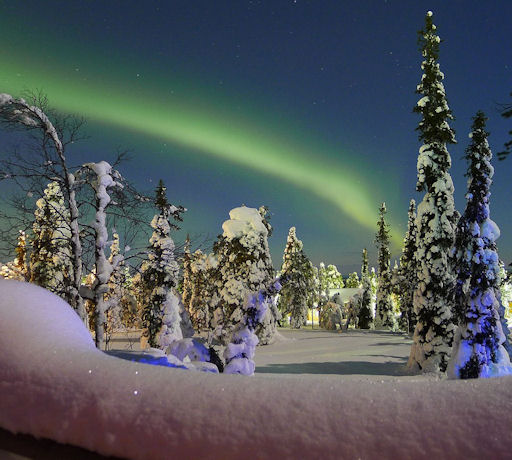CHANCE OF FLARES: Today, NOAA forecasters estimate a 75% chance of M-class solar flares and a 30% chance of an X-flare from big sunspot AR1429.The active region is slowly turning to face Earth, so if any such eruptions do occur, they are increasingly likely to be geoeffective. Solar flare alerts: text, phone.
AURORA WATCH: High-latitude sky watchers should be alert for auroras on March 6th and 7th. Sunspot AR1429 has hurled two CMEs into space since it emerged over the weekend. Neither cloud is heading directly toward Earth, but both could deliver glancing blows to our planet's magnetic field. NOAA forecasters say there is a 30% to 40% chance of polar geomagnetic storms during the next 24-48 hours.
Even before the CMEs arrive, auroras are already dancing around the Arctic Circle:
"Even the bright moon and street lights couldn't hide the auroras on March 4th," says photographer Timo Newton-Syms of Ruka, Finland. "They lasted for a couple of hours after dusk, sometimes with short bursts all over the sky." Aurora alerts: text, phone.
more images: from Chad Blakley of Aurora Sky Station, Abisko National Park, Sweden; from Pavel Kantsurov of Norilsk, Russia; from Frank Olsen of Tromsø, Norway; from Darrell Jordan of Ersfjordbotn Norway
CONVERGING PLANETS: Go outside at sunset and look west. Venus and Jupiter are converging there for a 3o conjunction on March 12th and 13th. Even now, more than a week away from closest approach, the bright duo are a wonder to behold:
"They are like glowing lamps in the sky," says photographer M. Raşid Tuğral, who created this astronomical self-portrait at his home in Ankara, Turkey. "I really enjoyed them tonight and also the reddish planet Mars."
As the distance between Venus and Jupiter shrinks, something interesting happens. The converging pair can actually become physiologically mesmerizing, according to NASA. Do you find these planets hypnotic? Submit your answers with photos here.
more images: from Harrison Chu of Hualien, Yuli ,Taiwan; from Tamas Abraham of Zsambek, Hungary; from Peter Hill of Burton upon Trent UK; from Gene Taylor at the Cold Mountain Overlook on the Blue Ridge Parkway;

![]()
Solar wind
speed: 379.7 km/sec
density: 4.1 protons/cm3
explanation | more data
Updated: Today at 1605 UT
![]()
X-ray Solar Flares
6-hr max: M2 1241 UT Mar06
24-hr: M2 1241 UT Mar06
explanation | more data
Updated: Today at: 1600 UT
![]()
![]()
![]()
Daily Sun: 06 Mar 12
![]()
![]()
Big sunspot 1429 poses a continued threat for X-class solar flares. Credit: SDO/HMI
![]()
![]()
![]()
Sunspot number: 105
What is the sunspot number?
Updated 05 Mar 2012
Spotless Days
Current Stretch: 0 days
2012 total: 0 days (0%)
2011 total: 2 days (<1%)
2010 total: 51 days (14%)
2009 total: 260 days (71%)
Since 2004: 821 days
Typical Solar Min: 486 days
Updated 05 Mar 2012
The Radio Sun
10.7 cm flux: 132 sfu
explanation | more data
Updated 05 Mar 2012
![]()
![]()
![]()
Current Auroral Oval:
![]()
Switch to: Europe, USA, New Zealand, Antarctica
Credit: NOAA/POES
![]()
![]()
![]()
Planetary K-index
Now: Kp= 2 quiet
24-hr max: Kp= 3 quiet
explanation | more data
![]()
Interplanetary Mag. Field
Btotal: 2.5 nT
Bz: 1.1 nT south
explanation | more data
Updated: Today at 1606 UT
![]()
![]()
![]()
Coronal Holes: 05 Mar 12
![]()
![]()
A solar wind stream flowing from this coronal hole could reach Earth on March 8-9. Credit: SDO/AIA.






